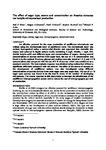THE EFFECT OF SUGAR TYPE, SOURCE AND CONCENTRATION ON CAULIFLOWER (BRASSICA OLERACEA VAR. BOTRYTIS) MICROSHOOT PRODUCTION
| dc.contributor.author | Rihan, HZ | |
| dc.contributor.author | Al-Shamari, M | |
| dc.contributor.author | Al-Swedi, F | |
| dc.contributor.author | Burchett, S | |
| dc.contributor.author | Fuller, MP | |
| dc.date.accessioned | 2016-02-04T17:23:05Z | |
| dc.date.available | 2016-02-04T17:23:05Z | |
| dc.date.issued | 2015-09 | |
| dc.identifier.issn | 0567-7572 | |
| dc.identifier.issn | 2406-6168 | |
| dc.identifier.uri | http://hdl.handle.net/10026.1/4265 | |
| dc.description.abstract |
An effective protocol for the mass production of cauliflower microshoots was refined using the meristematic layer of cauliflower curd. The meristimatic layer was excised, homogenized using a commercial blender and separated into desirable size classes and cultured in liquid culture media containing 2 mg/L kinetin, 1 mg/L IBA (indole butyric acid) and different types and concentrations of sugars. Among several concentrations of sucrose derived from sugar beet, the use of 3% concentration was found to be the optimal. Fructose, glucose and maltose were also tested at 1.5, 3, and 4.5% concentrations and compared with the use of 3% of sucrose which was considered as a standard (control). The best explants response was obtained using maltose but without a significant difference compared with the control. The effect of the source of sucrose on the development of cauliflower culture was also investigated using different concentrations of sucrose derived from both sugar cane and sugar beet. The use of 4.4% sugar cane sucrose was found to be the best in terms of the number of developing microshoots. The results reported in this study help to increase the effectiveness of the cauliflower micropropagation system and to reduce the cost of micropropagule per unit of production. | |
| dc.format.extent | 87-94 | |
| dc.language.iso | en | |
| dc.publisher | International Society for Horticultural Science (ISHS) | |
| dc.subject | sugar | |
| dc.subject | sucrose | |
| dc.subject | sugar cane | |
| dc.subject | micropropagation | |
| dc.subject | meristematic tissue | |
| dc.title | THE EFFECT OF SUGAR TYPE, SOURCE AND CONCENTRATION ON CAULIFLOWER (BRASSICA OLERACEA VAR. BOTRYTIS) MICROSHOOT PRODUCTION | |
| dc.type | journal-article | |
| dc.type | Proceedings Paper | |
| plymouth.author-url | https://www.webofscience.com/api/gateway?GWVersion=2&SrcApp=PARTNER_APP&SrcAuth=LinksAMR&KeyUT=WOS:000378644300006&DestLinkType=FullRecord&DestApp=ALL_WOS&UsrCustomerID=11bb513d99f797142bcfeffcc58ea008 | |
| plymouth.issue | 1099 | |
| plymouth.volume | 1099 | |
| plymouth.publication-status | Published | |
| plymouth.journal | Acta Horticulturae | |
| dc.identifier.doi | 10.17660/actahortic.2015.1099.6 | |
| plymouth.organisational-group | /Plymouth | |
| plymouth.organisational-group | /Plymouth/Faculty of Science and Engineering | |
| plymouth.organisational-group | /Plymouth/Faculty of Science and Engineering/School of Biological and Marine Sciences | |
| plymouth.organisational-group | /Plymouth/REF 2021 Researchers by UoA | |
| plymouth.organisational-group | /Plymouth/REF 2021 Researchers by UoA/UoA06 Agriculture, Veterinary and Food Science | |
| plymouth.organisational-group | /Plymouth/Users by role | |
| plymouth.organisational-group | /Plymouth/Users by role/Academics | |
| dc.rights.embargodate | 2016-03-01 | |
| dc.identifier.eissn | 2406-6168 | |
| dc.rights.embargoperiod | 6 months | |
| rioxxterms.versionofrecord | 10.17660/actahortic.2015.1099.6 | |
| rioxxterms.licenseref.uri | http://www.rioxx.net/licenses/under-embargo-all-rights-reserved | |
| rioxxterms.type | Journal Article/Review |


